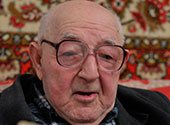
Yosl Kogan was born in 1927 in Bershad. His father, a soap-maker, died during the 1933 famine. He was brought up by his mother, a candy-maker. He spent much of the war in the Bershad ghetto, where he wrote songs about his experiences. He served in the Red Army and participated in the liberation of Berlin. After his military service, he worked at a liquor factory in Bershad, draining molasses. He moved to Tulchyn in 1960 and worked in a procurement office.
Other Interviews:
"I love Yiddish"Valik, Zhuzhia and Ivanov
"And every day we waited to die"
Tsezeyt un tseshpreyt (Scattered and dispersed)
Inside the Ghetto
Aheym, briderlekh, aheym (Homeward, brother, homeward)
From the Chimney to Berlin
Bershad
Throughout March 1944, the Red Army slowly inched westward across Ukraine, liberating the lands of Vinnytsya Province from German occupation. In Transnistria, Soviet soldiers found pockets of surviving Jewish communities: they liberated 12,000 indigenous Jews and another 40,000 Romanian Jews who had been deported to the region from their homes.
In the Reichskommissariat the Red Army found no intact Jewish communities; there were only individuals who had managed to survive the occupation in hiding, usually in isolation.
The occupation was over, but the war was not.
Young men throughout the region were immediately drafted into the military, scooped up by the war machine, and joined the historic journey westward toward Berlin.
They would end the war not as victims, but as victors. “As soon as the Red Army came, they took me. I was only seventeen years old,” recalls Yosl Kogan of his liberation. “They took me to the draft office and asked: ‘Were you under occupation?’ I answered, ‘Yes, I was under occupation.’ So they took me to the draft office and the Reds enlisted me in military training.” After a truncated training in Rzhev, some 1,200 kilometers to the east, Kogan was placed in the first reserve rifle regiment and sent into the bloodiest front in human history.
In this clip, Kogan frames the narrative of his journey to Berlin as a story of peripeteia, a sudden reversal of fortune, from what seemed like certain death to a spectacular victory. Kogan, who had briefly been imprisoned in the Pechera concentration camp, escaped, weakened, with swollen legs, and near death, back to Bershad, where he hid from the Romanian gendarmes in a chimney. In his telling, he emerged from his hiding spot to join the Red Army and fight all the way to Berlin, where he was able to inscribe his name on the Reichstag as a victor:
I went inside a chimney, where I could hardly breathe. I almost suffocated there. I had to hold my nose. At night, I would go out because my nose was bleeding. . . . When my mother, may she rest in peace, was already gone, I went to a non-Jewish woman. The woman took me in and I went up to the attic. And I spent a week lying in the attic. They couldn’t give me any food. Telling you about such things, I can’t fully describe to you what I lived through. And afterwards, the Red Army came and drafted me into the army. At the age of seventeen, I was off and in the army for seven years. I served at the front for two months. I went all the way to Berlin.
Many Soviet Jews embed the victorious narrative of the Great Patriotic War into their life stories. Veterans of the Red Army view themselves as victors, and not just victims. Yosl Kogan’s story of how he escaped from the chimney and managed to join up with the Red Army to fight in the battle for the Reichstag is emblematic of this triumphalism. The cult of the war resonated with Soviet Jews, who prided themselves on their role in the victory. Emphasizing their victimhood, on the other hand, brought no material advantage from the state or sympathy from the community. On the contrary, it brought them under suspicion for having lived under German occupation.
Survivors struggled to mourn for the dead and took measures to commemorate their losses, but they were more likely to emphasize the disproportionate number of Jews who fought than the disproportionate number of Jews who were murdered.
Source: Jeffrey Veidlinger, In the Shadow of the Shtetl: Small-Town Jewish Life in Soviet Ukraine (Indiana University Press, 2013)
